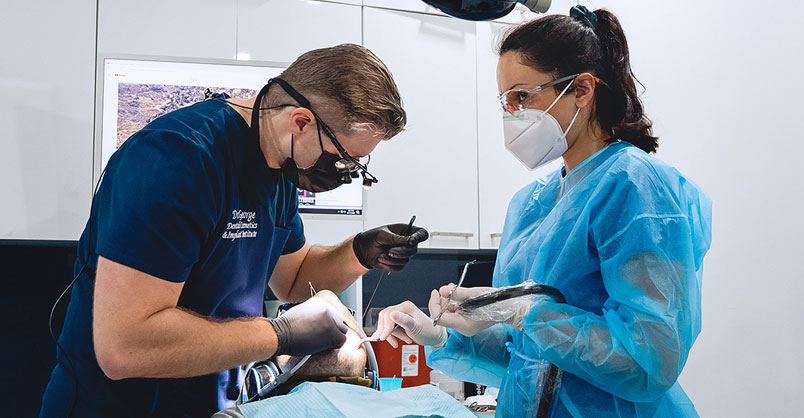What Are the Benefits of Getting Veneers and How Are Teeth Prepped for Them?
Veneers have become a popular cosmetic dental solution for individuals looking to enhance their smiles. Whether you have stained, chipped, or misaligned teeth, veneers provide a quick and long-lasting way to achieve a flawless smile. However, the process involves preparing your teeth correctly to ensure the best results. In this article, we’ll explore the benefits of getting veneers and how teeth are prepped for the procedure.

What Are the Benefits of Getting Veneers?
Getting veneers offers numerous advantages for those seeking a bright and even smile. Some of the key benefits include:
1. Improved Aesthetics
Veneers instantly enhance the appearance of your teeth. They cover imperfections such as discoloration, chips, and gaps, creating a natural and attractive smile.
2. Stain Resistance
Unlike natural teeth, veneers are resistant to stains from coffee, tea, and other foods. This makes them an excellent choice for individuals who want a whiter smile without frequent whitening treatments.
3. Durability and Longevity
Porcelain veneers, in particular, are highly durable and can last 10 to 15 years with proper care. They are strong enough to withstand daily activities such as eating and speaking.
4. Minimal Tooth Reduction
Compared to dental crowns, veneers require only a small amount of enamel removal, making them a conservative option for cosmetic improvement.
5. Instant Confidence Boost
A beautiful smile can significantly impact self-esteem. Veneers help individuals feel more confident in social and professional settings.

How Are Teeth Prepped for Veneers?
Preparing teeth for veneers is a crucial step to ensure a proper fit and long-lasting results. The process is typically completed in a few steps:
1. Initial Consultation and Examination
Before starting the procedure, a dentist evaluates the patient’s oral health to determine if veneers are a suitable option. They may take X-rays and impressions of the teeth to plan the treatment properly.
2. Tooth Preparation
To accommodate the veneers, a thin layer of enamel (usually about 0.5 mm) is removed from the front surface of the teeth. This step ensures that the veneers sit flush with the rest of the teeth, providing a natural look and comfortable fit.
3. Impressions and Temporary Veneers
After enamel removal, the dentist takes impressions of the teeth, which are sent to a dental lab where the permanent veneers are custom-made. While waiting for the final veneers, temporary veneers are placed to protect the prepped teeth.
4. Bonding the Veneers
Once the permanent veneers are ready, the dentist removes the temporary ones and cleans the teeth thoroughly. A special adhesive is applied to the teeth prepped for veneers before placing the veneers, ensuring a strong bond. A curing light is used to harden the adhesive, securing the veneers in place.
5. Final Adjustments and Follow-Up
The dentist makes necessary adjustments to ensure a perfect fit and comfortable bite. A follow-up appointment may be scheduled to check the veneers' placement and overall comfort.
How to Care for Your Veneers?
To maintain the longevity of your veneers, proper oral care is essential. Here are some tips to keep them in top condition:
· Practice Good Oral Hygiene: Brush twice a day and floss regularly to prevent plaque buildup.
· Avoid Hard Foods: Chewing on ice, hard candy, or non-food items can damage veneers.
· Limit Staining Foods and Drinks: Although veneers are stain-resistant, excessive consumption of coffee, red wine, or dark sodas may affect their appearance over time.
· Wear a Mouthguard: If you grind your teeth at night, a mouthguard can protect both your veneers and natural teeth from damage.
· Regular Dental Check-Ups: Visiting the dentist for routine cleanings and exams helps maintain oral health and ensures the veneers stay in excellent shape.
Are You a Good Candidate for Getting Veneers?
Not everyone is an ideal candidate for veneers. Individuals with significant tooth decay, gum disease, or severe misalignment may need other treatments before getting veneers. Consulting with a dentist will help determine whether veneers are the right solution for your smile goals.
Conclusion
Getting veneers is a transformative cosmetic dental procedure that provides numerous benefits, from enhanced aesthetics to increased confidence. Understanding how teeth are prepped for veneers ensures that you know what to expect during the process. If you’re considering veneers, schedule a consultation with a qualified dentist to discuss your options and achieve the smile of your dreams.
Comments
Post a Comment